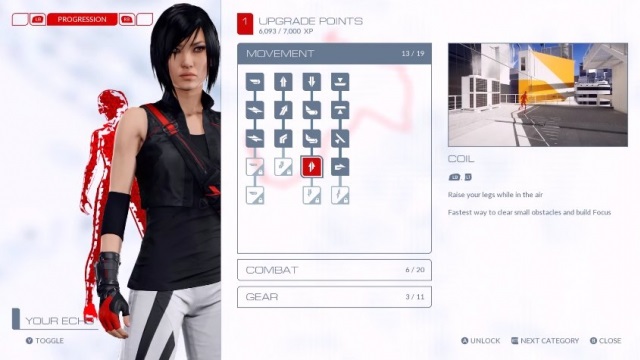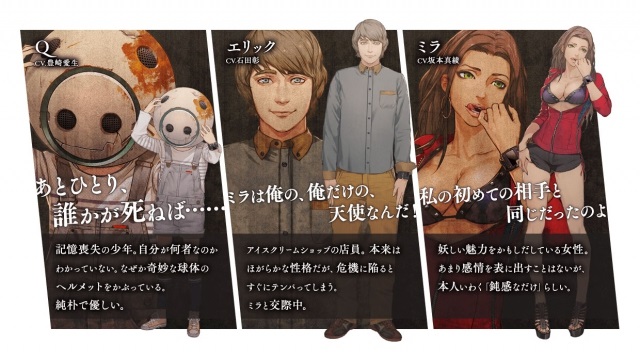Michael Gee
![]()
In the late years of the last decade, Electronic Arts was not the punching bag for homogenous game design that it is today. At that time, EA was promoting a handful of original, eye-catching titles separate from licensed titles and sports releases in every column. Among those more curious titles (including Mass Effect, Dragon Age, Skate, and Dead Space) was the original Mirror’s Edge, a stylish first-person runner touting a focus on flowing parkour movement, conflict avoidance, and an experimental love-it-or-hate-it control scheme. Unfortunately, the game did not turn the numbers desired and the IP faced early retirement. Now the reboot, Mirror’s Edge: Catalyst, is on the horizon, leading an upcoming trend of second chances for niche titles—and we would be wise to acknowledge that these releases may be very different from the originals that were so pined for. After all, the developers are counting on it.
The marketing for Catalyst sports a ‘2.0’-esque visual direction, a greater focus on characters, and a more dramatic, theatrical script from what has been shown in the trailers. On the side of player interaction, we’ve seen an open world, experience bars, and skill trees that gradually unlock controls. By extension, you might expect that we’ll climb towers throughout the course of the game to reveal more of the map and bonus objectives. Given that these were absent from the original title and that there has been a more vocally negative reaction than not to these additions, we should ask, ‘what prompted these changes?’

At release in 2008, EA projected Mirror’s Edge to sell in the range of 3 million units. A month later EA reported sales breaking 1 million. By mid-2013, the title had managed 2.5 million. If that 3 million was broken, it was much later in the life cycle than desired. One might assume that it either netted a loss or did not make significant gains, given that talk of another Mirror’s Edge game dried up shortly after release. But the game wasn’t a failure in a critical sense. While the script and characters didn’t find universal or even cult praise, there was a very real demand to see a more complete story, for more parkour, for more Mirror’s Edge.
After release, EA found themselves sitting on a property with a wanting fanbase, but unable to financially justify moving forward with disappointing sales figures. This is where several companies holding onto darling titles may have found themselves. Many of these games are in a tragic position in which the things that make up their core gameplay are also the factors that may limit their mass appeal, and when sitting with AAA publishers, there is rarely a seat at the table for projects with mid-sized budgets for a mid-sized audience (and that is a problem which demands an entirely separate discussion). So when wanting to make the most of a waiting audience while carrying a go-big-or-go-home approach, simply making Mirror’s Edge 2 was not an acceptable option.
Hence the current state of Catalyst. There are elements of gameplay that developer EA DICE can’t change without removing the original appeal of Mirror’s Edge. Action-based gameplay which didn’t rely on beating the opposition to a pulp brought consumers looking for something new, and confused buyers who couldn’t attach the game to something familiar. The unique movement and control system had depth that allowed players to see levels in new ways as they ran up more hours, but drove away those baffled by unfamiliar single-inputs and button combinations. However, the gamers that committed in full can and have spent dozens of hours running time trials and challenge course DLC—the game remains a popular choice for speedrunners who have honed puppet master-like skills.
Returning to Catalyst, the future is experience bars, skill trees, and all the other trimmings that became standard for front-and-center game releases. On one hand, this is DICE adding game elements that have worked in player retention and extending the shelf life of a game. On the other hand, it is cynical, by-the-numbers game design that acts as bloating sawdust filler. Whether or not this is approach to Catalyst is a boon or a hindrance is yet to be seen, but Catalyst is only the harbinger of a wave of cult-classic-second-shots.

Ubisoft has been teasing a sequel to the critically acclaimed Beyond Good & Evil for years now, but what are we looking at as far as significant alterations to gameplay? Will the setting retain the wonder and fantasy of the original, or will we witness gritty reboot syndrome as in the case of Jak and Daxter to Jak II? Will main character Jade’s background as a photojournalist remain relevant?
Zero Time Dilemma, the third game of the room-escape/visual novel Zero Escape series seemed as if it would never see production due to its lack of commercial success, but a combination of developer persistence and fan enthusiasm helped bring development back. However, Dilemma’s visuals have abandoned the bold colors and anime pop of the two games before it for softer lines and more subtle colors, and a few characters that look jarringly grounded next to the boy with a robot head and thigh-high overalls. This change is perhaps an attempt to reach wider audiences with a look that may test better with the themes of the game, but is unpopular with those who are already fans.

Reactions from the fanbases for second chance titles are often critical, sometimes fraught with a sense of betrayal. However, presentation and game design face changes because there is no benefit to following a formula that didn’t get the desired results. We’ve often seen revivals for strong franchises that had debatably stagnated, sometimes for the better (Tomb Raider [2013], Resident Evil 4), and sometimes for the worse (Duke Nukem Forever, Resident Evil 6). What we may be looking at over the next few years are revivals for games that never reached commercial success to begin with, and may be subject to even greater change.
Fans of second chance niche games should brace themselves for more changes to be made to their beloved titles, especially if the game comes from AAA houses such as EA or Ubisoft. What expectations are there if Capcom pulls out Mega Man Legends 3 in a few years, or Square Enix presents a proper third Chrono title? As more cult games are brought out of retirement, audiences will want to reflect on what changes they’re willing to put money on, and whether the elements that made up the soul of the game are still there for them. It’s worth asking: are these the continuations we asked for or the games that we’re stuck with?
Mirror’s Edge is one of my brother-in-law’s favorite games. I don’t think it needs a skill tree. Faith’s vulnerability against bullets was an important part of what the game did, giving a sense of urgency to the movement and encouraging reflexive reaction to environmental cues. I’m expecting skills that add higher bullet resistance and slowing down time, which are both ways to allow some players to complete the game at a speed that may not have been intended in the original design, but would allow a wider audience to feel like there’s some place for them in the games intended difficulty curve.
What this game absolutely does need is good level design, possibly with multiple routes and solutions that takes advantage of player creativity and choice. And a level editor. Just let people who love the game make awesome stuff for free. Even if it’s just on PC.
Sequels are inherently flawed. Striking a balance between “more of the same” and “different but not too different” while maintaining whatever magic mojo made a previous installment in the series successful is next to impossible. Perhaps appealing to a new audience on the foundation of an old game is the best way to expand on a universe. The mechanics of a game are only necessary to invest a player’s interest in a universe. It worked for XCOM:EU. The premise of the game was the same, the most basic mechanics of the game (i.e. turn based combat, permadeath, etc) were the same, but players who had come from the games previous generation still felt like they had lost something. At the same time, the game appealed to millions of new players who loved it, and as a result Firaxis has a new/returning hit franchise on their hands.
Whether or not we are getting proper sequels to the games we love might not be important, because in all likelihood the sequels that are being produced are aimed at an audience that have never played the previous games at all. We each have to decide what it is that tied us to these games in the first place, and evaluate whether we want more of exactly the same thing, or whether we ware willing to allow ourselves to be surprised by something new.
Killer write up Mike. I’m excited to keep reading these.
LikeLiked by 1 person